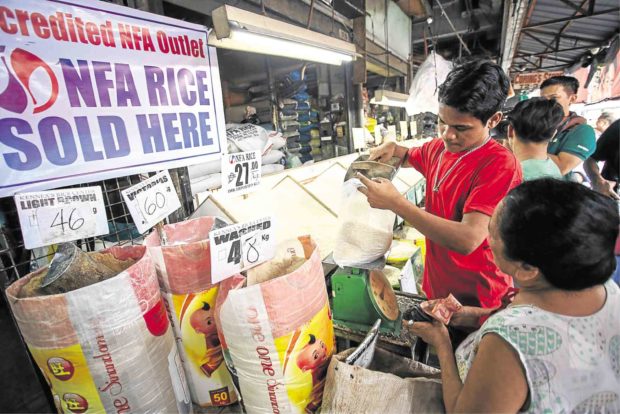Fighting inflation for the poor

The NFA has started the distribution of NFA rice to outlets in Quezon City, enabling consumers to buy more affordable milled rice. — JAM STA. ROSA
Inflation has surged to its highest rate in five years, reaching 5.2 percent in June 2018. Compare that with the 2.9 percent in May 2017. Driving it were the higher prices seen in rice, corn, fish and personal transport. This is beyond the 2-4 percent target of the government.
The knee-jerk public reaction is to blame the new tax reform or TRAIN law, but there are other factors.
Global oil prices are on the rise after long being subdued. The peso is getting weaker, so the rising exchange rate makes imports more expensive. And there were episodes of tight supplies of food.
The people are feeling the pain of inflation.
Social Weather Stations (SWS) tracks government performance on many fields every quarter. In the March 2018 survey, the administration scored weakest in fighting inflation. While 45 percent of the people were satisfied with it, 39 percent were dissatisfied, for a net rating of +6 percentage points. This is the lowest in almost two years.
Article continues after this advertisementThe Pulse Asia March 2018 survey finds that 98 percent of the people report inflation. Of this number, 86 percent say they are strongly affected by the price increases, 92 percent say that food prices have risen, along with 81 percent noting price hikes in rice, and ratios of 56 percent for soft drinks, 30 percent for electricity, 16 percent for gasoline or diesel, 12 percent for LPG and 7 percent for transport fares.
Article continues after this advertisementThe Philippine Statistics Authority (PSA) declared that inflation for the poorest 30 percent of the people rose by 5.3 percent in the first quarter of 2018. This is the highest level in four years, and the rate is pushed up by the price hikes in rice and food in general. Hence, food inflation, particularly rice inflation, needs special attention as it hits the poor the most.
Rice prices on the upswing
Average prices for regular milled began to increase by 2.6 percent in the first week of January, compared to a year before. Rice price inflation rose further to 7.8 percent in the second week of April. So why did rice prices surge?
The National Food Authority (NFA) keeps a buffer stock of cheap rice good for 15 days during the harvest season and 30 days during July to September, or the lean months. This is meant as “insurance” for emergencies. Now, the country suffered two big calamities in 2017: the eruption of Mayon volcano and the Marawi siege. The government deployed NFA rice for these disasters. However, the NFA did not restock the rice immediately.
The government admitted in February 2018 that its NFA rice stock was lacking. Then by April the rice stock was down to less than a day’s worth. So the poor shifted from buying cheap NFA rice to commercial rice. The increase in demand thus raised the price of commercial rice. Government thus approved in May a big import order of rice for the NFA.
This was somewhat similar to the rice crisis in 1995. The NFA recommended importing 700,000 metric tons (MT) of rice, but the Department of Agriculture agreed only to 263,000 MT. The resulting shortage doubled the price of rice.
Rice from Vietnam and Thailand
Rice is usually imported from Vietnam and Thailand, as it is much cheaper, at only around half the price of Philippine rice. This is because those two nations produce rice more abundantly: They are blessed with huge river systems, the Chao Phraya in Thailand, and the Mekong in Vietnam.
Importing huge amounts of rice is a tricky business because of all the uncertainty. In years like 2018, the government underimported, but in 2010, it overimported. For decades, the NFA has held the monopoly over rice imports. That is where the problem lies —any economics student knows that monopolies are harmful.
The government is now correcting this.
In late April, Malacañang removed import quota restrictions, allowing the private sector to buy more rice from abroad. But the country’s economic managers want to push this further. They call on Congress to pass the Rice Tarrification Act immediately.
This act will liberalize rice imports, and it works like this. Private traders can import rice but must pay a 35 percent tariff or tax on imports. This will result in rice that is P7 cheaper per kilo than current levels.
Many will benefit from this. The poor and consumers in general will buy cheaper rice. Government will get revenue from the tariffs. Traders will have a new source of profit. The NFA will save much money it uses for its imports. The country will have food security, as imports will not go through the slow process of public bidding and the layers of approval along the bureaucracy.
To fight the present wave of inflation and to relieve price pressures on the poor, Congress must target the core food item. Liberalize rice imports.—CONTRIBUTED